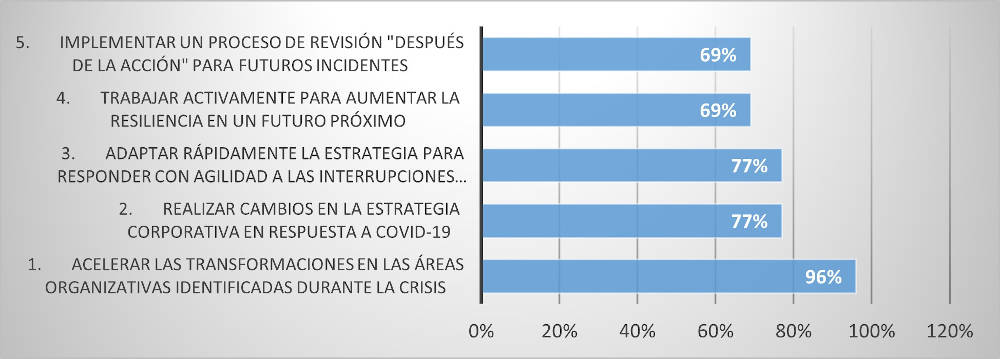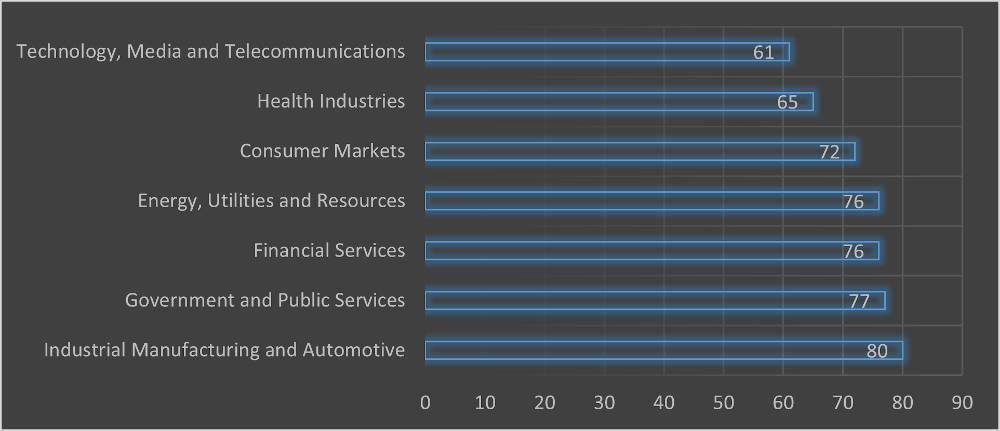
“Los líderes empresariales reconocen que una base sólida en resiliencia puede marcar la diferencia entre permanecer en tiempos de crisis o de paz”.
Building Resilience for the Future: Excerpts and commentaries
This year’s Global Crisis Survey is PwC’s second data collection and analysis. The first, published in 2019, revealed that 95 percent of respondents believed a crisis was imminent in the next two years. But the list of possible crises did not include the pandemic, which had disappeared entirely from threats, business leaders said they feared.
PwC’s Global Crisis Survey 2021 examines the global business community’s response to the most disturbing global crisis of our lives: the COVID-19 pandemic.
Global Crisis Survey 2021. Building resilience for the future
Three points to consider and evaluate:
1. Organizations with a strategic crisis response plan can mobilize faster, stabilize company operations and respond effectively to shockwaves from disruption.
With a well-defined team, organizations need an agile program that can be flexed to cope with various crises and contingencies. Only 35% of respondents had a very relevant crisis response plan, which means that most organizations did not design their plans for the crisis, a distinctive feature of resilient organizations.
What should companies do today to prepare for the next inevitable disruption?
- a) Designate a crisis response team: When a crisis occurs, your team will be able to quickly mobilize and adapt, execute a plan you’ve tested and perfected, and maintain your critical operations.
- b) Design a crisis response plan aligned with your strategy, objectives, and purpose: A clearly defined crisis strategy shared with the entire organization points to the importance of going beyond a box marking plan.
- c) Focus on continuous improvement and building an integrated resilience program: Review and refine your response in real-time and post-action assessments.
2. Break the silos. An integrated response is essential to implement a crisis management program and to build resilience.
Among respondents who said they had been adversely affected by the crisis or worse in a worse financial position, crisis management, business continuity, and emergency planning top the list of resilience strategy priorities.
7/10 organizations reported that they plan to increase their investment in resilience development.
3. The organization’s ability to recover is critical, not only to succeed but to survive.
Business leaders recognize that a resilience base can make the difference between staggering or in crisis or peacetime.
What exactly does resilience mean? In simple terms, it’s the ability to recover from disorders. Persevere. But it’s also about being prepared to allow and secure new possibilities.
How to get it?
- First, you must raise resilience within the organization.
- Secondly, take a picture of your crisis structure. Where are your strengths? Is your program comprehensive? Are you aligned with your strategic priorities? (Design an integrated program that clearly defines the roles and responsibilities for crisis management).
- Third, start fostering a culture of resilience across the enterprise.
And finally, tactically: examine your crisis response strategy across your organization.
Build resilience
92% of organizations surveyed had a post-action review process established before COVID-19 and conducted a formal post-action review of their pandemic response plan to have a process in place for future disruptions.
The Top 5 of the measures were taken when organizations realized that the pandemic was going to have a significant impact are as follows:

The Top 5 measures that the organizations surveyed plan to take now are as follows:

Companies that achieved better results, in general, delved a little deeper than routine communications. These organizations were more likely to:
- Identify relevant information promptly.
- Adopt stakeholder initiatives based on their response strategy and priorities.
- Frequently participate in understanding the impact of stakeholders.
Some unexpected benefits may arise from increased interaction. In Hungary, for example, a professional service provider said that before the crisis, group work sessions were scarce. However, with the start of remote work, the company successfully launched a new series of meetings and workshops for the entire company.
How sectors have fared
Organizations in these sectors experienced a “negative” and “significantly negative” impact:

Global Crisis Survey 2021-Mexico chapter
What is the situation and its particular implications for the Mexican companies –after one year of crisis by COVID-19?[1] In this year’s edition, the Global Crisis Survey (GCS) is focused on finding data that reveals the perspectives of different mexican business leaders after nearly 12 months of health crisis and economic slowdown, as well as the status of business response and continuity plans that they implemented or updated because of the pandemic.
Learning and preparation are two of the first lessons that emerge after a crisis. The survey indicates that 65% of participating organizations have a business continuity plan, and 48% have a crisis response plan.
Different prospects for the same crisis[2]
In Mexico, the results indicate the possible existence and use of a culture of prevention, which would have been developing since 2009, with the A(H1N1) epidemic, and which strengthened organizations when the 2020 health crisis needed to be responded to 81% of national respondents note that their organizations were prepared to deal with the impacts of the pandemic; globally, this percentage reaches 62%. In addition, 66% of respondents in Mexico consider the impact COVID-19 has had on their organizations negative. In the world, this response reaches 73%. On the other hand, 20% globally perceive that the pandemic has positively impacted, compared to 28% by mexican organizations. This prospect of strength and responsiveness in the face of such a unique crisis is also detected in future scenarios. While 64% of respondents globally say their organizations are prepared to assess the threats that could impact their long-term corporate strategy, this percentage reaches 81% in Mexico.
The results of the Global Crisis survey reveal that 66% of organizations in Mexico consider the impact of the pandemic to have been negative, while, in the world, this happens by 73%.
28% of national respondents see a positive impact, compared to 20% globally.
New opportunities and challenges in the use of technology
For companies, responding to and adapting to the crisis has meant technological solutions and the acceleration of their digitization processes. 93% of respondents in Mexico report that technology has facilitated the coordination of their organization’s response team.
Additionally, 84% believe that technology has improved the organization’s ability to gather appropriate information to help make decisions.
However, implementing these solutions has also opened the door to other technological vulnerabilities that must be included in the response plan. 74% identified deficiencies and took steps to improve the area of information security and privacy as part of containment to the impacts of the pandemic.
Within a crisis management plan, the use of technology is one of the points to review to take lessons and find the areas that serve as the basis for a new model of continuous improvement of incident responses. This action has been paramount during the pandemic. Organizations in Mexico mentioned that, as a result of the effects of COVID-19, its three main areas with changes or acceleration of transformation are: IT infrastructure (59%), technological transformation (56%), cybersecurity or privacy (51%).
Four best practices to adapt to a crisis[3]
- Find and maintain reliable and accurate sources of information. The quality of information an organization collects must be fact-based. The sooner the cause and facts of an event can be discerned and identified, the faster and more successful the response will be.
- Evaluate strategically. A review exercise or after-action review of crisis management should consider: Governance and Leadership Strategy, Company Integration, Degree of Alignment with What Happened, Uncovered Areas, Management and Impact on Stakeholders, Use of Technology, Lessons Learned and Strategy Calibration.
- Invest with business continuity in thinking. Any investment to deal with a crisis must go beyond getting a return on investment. This is part of the business continuity strategy and protecting tangible or intangible assets, brands, reputation, and human capital.
- Work for continuous improvement of response teams. While there are precise lines of work, the roles of the response team may change depending on the type of organization and vulnerabilities detected. A revised and adapted definition of roles and levels of involvement makes members feel engaged in any initiative they launch.
Permanent work teams: the best armor
Preparing to respond to a crisis begins by establishing functions and response teams. The capabilities are available to anticipate crisis scenarios, determine the best way to respond, and reflect on how to plan, implement and evaluate response programs.
- Operational Functions. Understand and implement response plans for potential effects on the company’s operation: supply chains, production, workforce, inputs, etc.
- Legal and regulatory functions. Anticipate what would happen in a crisis under certain events that affect the company’s operations and could have contractual or labor impacts.
- Communications functions. Identify the best communication mechanisms inside and outside the company. Establish and strengthen communication channels to collect and transmit information.
Conclusions
Although the Pandemy’s effects have not ended yet, we can reach some conclusions I deem important for all companies to consider in ther Business Recovery Plans (BRP) and Business Disaster Plans (BDP):
- Organizations with a strategic crisis response plan can mobilize faster, stabilize company operations, and respond effectively to disruption.
- Preparedness, agility, an integrated crisis response plan, and resilience have been essential for organizations to continue the crisis and remain critical when moving on to the post-pandemic period.
- A culture of prevention, not only in crisis but also of other events such as cyberattacks, violation of regulations, fraud, or corruption, is essential to design a robust response program.
- Preparing to respond to a crisis begins by establishing functions and response teams. The capabilities are available to anticipate crisis scenarios, determine the best way to respond, and reflect on how to plan, implement and evaluate response programs.
It is important to remember, COVID-19 is the second pandemy we live; H1N1 Flu were the first warning that something like this would happen and we did not learn nor fast nor responsive. Hopefully we will learn important lessons from this experience to strenghten our companies and organizations, and societies as a whole.
References:
[1] PwC. Global Crisis Survey 2021, “Chapter Mexico“.
[2] PwC Global Crisis Survey 2021, Chapter Mexico, “What is the situation of Mexican companies to one year of crisis by COVID-19?”.
[3] PwC Global Crisis Survey 2021, Chapter Mexico, “4 best practices to adapt to a crisis“.










